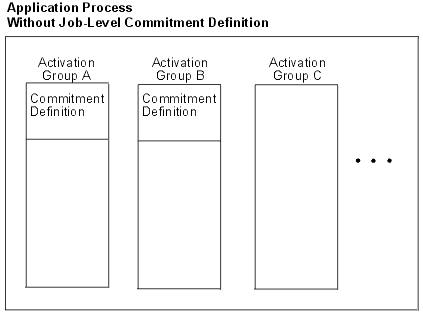Application processes, concurrency, and recovery
All SQL programs execute as part of an application process. In the IBM® i operating system, an application process is called a job. In the case of ODBC, JDBC, OLE DB, .NET, and DRDA, the application process ends when the connection ends even though the job they are using does not end and may be reused.
An application process is made up of one or more activation groups. Each activation group involves the execution of one or more programs. Programs run under a non-default activation group or the default activation group. All programs except those created by ILE compilers run under the default activation group. For example, LANGUAGE JAVA external functions run under the default activation group.
For more information about activation groups, see the book ILE Concepts .
.
An application process that uses commitment control can run with one or more commitment definitions. A commitment definition provides a means to scope commitment control at an activation group level or at a job level. At any given time, an activation group that uses commitment control is associated with only one of the commitment definitions.
A commitment definition can be explicitly started through the Start Commitment Control (STRCMTCTL) command. If not already started, a commitment definition is implicitly started when the first SQL statement is executed under an isolation level different than COMMIT(*NONE). More than one activation group can share a job commitment definition.
Figure 1 shows the relationship of an application process, the activation groups in that application process, and the commitment definitions. Activation groups A and B run with commitment control scoped to the activation group. These activation groups have their own commitment definitions. Activation group C does not run with any commitment control and does not have a commitment definition.

Figure 2 shows an application process, the activation groups in that application process, and the commitment definitions. Some of the activation groups are running with the job commitment definition. Activation groups A and B are running under the job commitment definition. Any commit or rollback operation in activation group A or B affects both because the commitment control is scoped to the same commitment definition. Activation group C in this example has a separate commitment definition. Commit and rollback operations performed in this activation group only affect operations within C.

For more information about commitment definitions, see the Commitment control topic.